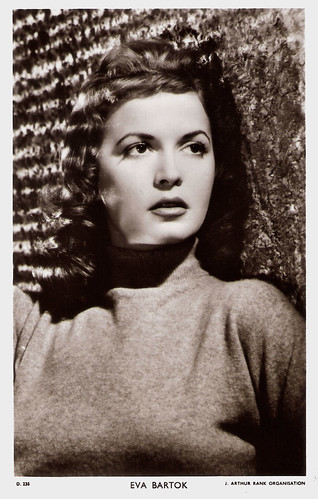
British postcard in the Picturegoer Series, London, no. D 235. Photo: J. Arthur Rank Organisation.
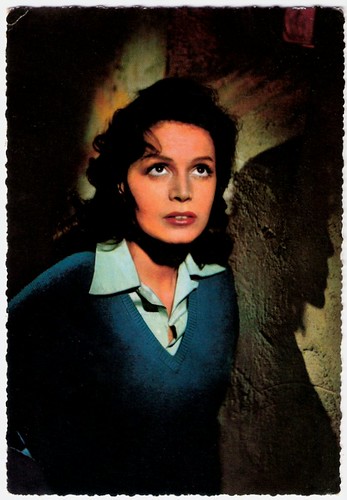
German postcard by Krüger, no. 902/50.

German postcard by WS-Druck, Wanne-Eickel, no. F 49. Photo: Ringpress.

Dutch postcard by Rank. Photo: Rank. Eva Bartok and Peter Finch in Amsterdam during the shooting of the British WWII film Operation Amsterdam (Michael McCarthy, 1959). The film was produced by Maurice Cowan and Rank and distributed by Rank and 20th Century Fox.
Surviving Nazism and Communism
Eva Bartok was born Eva Martha Ivanova Szöke in Budapest, Hungary, in 1926 (some sources say 1927 or 1929). Her father was a Jew who had married a Catholic lady and who wrote of political issues and social commentary in Budapest newspapers. During the rise of Nazism in Europe, he sent his wife and daughter to live in Kecskemét, south of Budapest, where his wife had relatives. He would visit them on Sundays and take Eva out to the local children's venues. In time those visits became less frequent until they stopped altogether. Her father disappeared without a trace. As the daughter of a Jew, Eva escaped the German concentration by marrying a Nazi officer, Geza Kovacs, at age 15. After the war (some sources say in 1942), the marriage was annulled on the grounds of coercion of a minor. She later described the arranged marriage as a "series of brutal rapes worse than death."
Having survived Nazism and World War II, she found her vocation in acting. In 1945, Eva Szöke made her stage debut in J.B. Priestley's 'A Conway család' (Time and The Conways) at the Belvàrosi Szinhàz theatre in Budapest. On his tribute site for Bartok, Omar Martinez writes that “the newspapers reported that a new talent had appeared on the Budapest stage. All drama critics agreed that the newcomer was simply sensational and Eva's reputation grew with each performance.” The play ran for three months at the theatre, very long at the time. Her next play, Gáspár Margit's farce 'Új Isten Thébában' (New God in Thebes, 1946), would prove an even greater success. It was followed by the drama 'Hullámzó vőlegény' (Waving Groom, 1947), written by one of Hungary's most popular writers Áron Tamási. The latter was a great success on opening night, but the Communist-controlled publications were unanimous in panning both the play and the performances.
Tamási also wrote her first and only film in Hungary, the independent production Mezei próféta/Prophet of the Fields (Frigyes Bán, 1947). Communist censorship banned the film one day before the premiere because the author and star hadn’t become party members. It was a clear message they could no longer ignore. Hollywood-based producer Alexander Paal helped her escape from Hungary by marrying her in 1948 and taking her to England. There she made her screen debut in Paal's production of A Tale of Five Cities/A Tale Of Five Women (Romolo Marcellini, Emil E. Reinert, Wolfgang, Montgomery Tully, Géza von Cziffra, 1951) with Gina Lollobrigida. She changed her name to Eva Bartok. The production was filmed in 1948 but shelved for several years due to financial difficulties.
After divorcing Paal in 1950, Eva received valuable support from film mogul and fellow Hungarian expatriate Alexander Korda who was then president of MGM-England. He placed her under contract to London Films which provided a small salary, an English language coach and the opportunity to audition for developing film projects at the studio. In spite of this, Eva Bartok spent months without finding real work and was becoming quite desperate.
William Wordsworth, a public relations man who became her third husband in 1951, suggested that she attend as many premieres and theatre opening nights as possible in order to bring attention to herself. Unable to buy the proper wardrobe and accessories to make a decent showing at these social gatherings, Eva began designing and making her own gowns and hats from pieces of cheap materials. Soon the media took notice of this beautiful brunette dressed in weird costumes and Eva Bartok became a local celebrity.
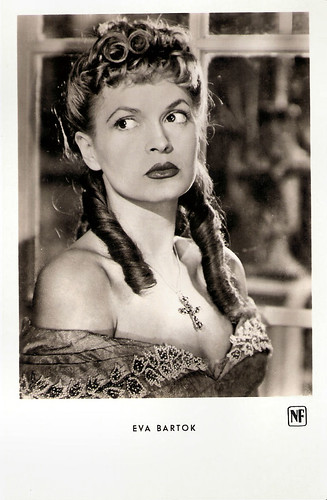
German postcard by Kunst und Bild, Berlin, no. A 853. Photo: NF. Publicity still for Der letzte Walzer/The Last Waltz (Arthur Maria Rabenalt, 1953).
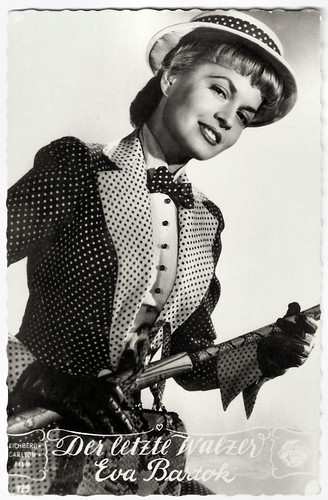
Austrian postcard by Verlag Hubmann, Wien, no. 729. Photo: Eichberg-Carlton-Film / International Film. Publicity still for Der letzte Walzer/The Last Waltz (Arthur Maria Rabenalt, 1953).

German postcard by Kolibri-Verlag, no. 1180. Photo: Meteor Schorchtfilm. Still from Orient Express (Carlo Ludovico Bragaglia, 1954) with Curd Jürgens.
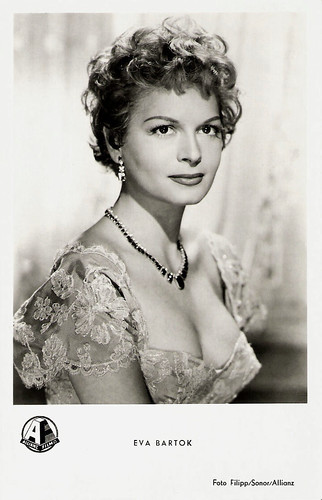
German postcard by Kunst und Bild Berlin, no. A 1143. Photo: Filipp / Sonor / Allianz. Publicity still for Viktoria und ihr Husar/Victoria and Her Hussar (Rudolf Schündler, 1954).
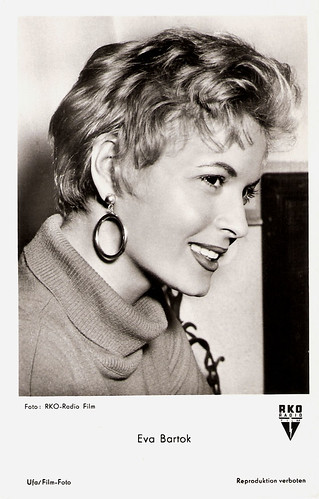
German postcard by Ufa, Berlin-Tempelhof, no. FK 998. Photo: RKO-Radio Film. Publicity still for Rummelplatz der Liebe/Circus of Love (Kurt Neumann, 1954).
Glamorous carefree playgirl
The publicity caught the eye of an Italian promoter who offered Eva Bartok a contract to perform in a vaudeville show at Teatro Manzoni in Milan. With Korda's permission, Eva flew to Italy and had great success on the stages of Milan, Florence and Rome. Meanwhile, in England, A Tale of Five Cities/A Tale Of Five Women had finally reached the cinemas and was seen by producer-actor Burt Lancaster and director Robert Siodmak who were looking for a leading lady for their next film The Crimson Pirate (Robert Siodmak, 1952). Impressed by Eva's beauty and talent, Lancaster wired to Italy and asked for her to attend a screen test. Bartok by now wary of countless unsuccessful auditions replied "No test. Send script." To her surprise, she was offered the role and was asked to report for location shooting on the island of Ischia.
After working in this film, Eva was perceived as a real movie queen but some of her next vehicles are not what you would expect from a rising superstar. She became more famous for her off-camera antics as a glamorous carefree playgirl among the European rich than for her screen work. Although her filmography in the 1950s is prolific both in England and in Germany, it includes a lot of low-budget turkeys, some decent vehicles and a few top productions.
She also made a series of films that paired her with Curd Jürgens, including Der letzte Walzer/The Last Waltz (Arthur Maria Rabenalt, 1953) and Orient Express (Carlo Ludovico Bragaglia, 1954). The popular actor-director became her fourth husband in 1955. Besides her work in films, she appeared on London stages and television. After turning down a Hollywood contract in 1956, Bartok found herself in a serious health crisis. Bartok suffered a bout of ovarian cancer while she was pregnant. An Indonesian mystic helped her out of this predicament with a new spirituality called Subud. Bartok gave ‘miraculously’ birth to a baby girl in 1957, Deana Jürgens. From then on she seemed totally committed to Subud.
In later years she revealed that daughter Deana had been fathered by Frank Sinatra during a brief affair that Bartok and Sinatra had in 1956. The claim went ignored by Sinatra and his family. After publishing her kiss-and-tell autobiography 'Worth Living For' in 1959, she would make a dozen more films including the Italian horror film Sei donne per l'assassino/Blood and Black Lace (Mario Bava, 1964). She retired from the cinema in 1967 at age 40 and went to live in Indonesia.
She taught philosophy in a school she opened in Honolulu and ran an arts centre in Los Angeles and a gallery in San Francisco. In the early 1980s, she returned to London. She continued her Subud activities during her residencies in Indonesia, Hawaii, San Francisco, Los Angeles and London. In the 1980s she married for the fifth time, with producer Dag Moline. Eva Bartok died in 1998 in London, UK of a heart failure.
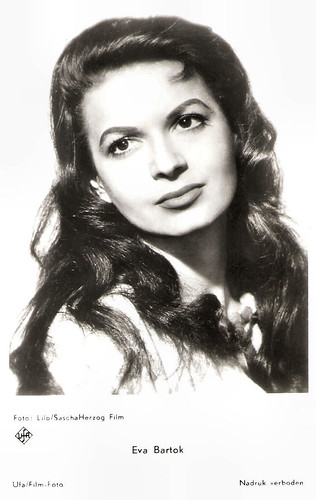
Dutch postcard by D.R.C. Holland, no. 2119. Photo: Lilo / Sascha Herzog Film / Ufa.
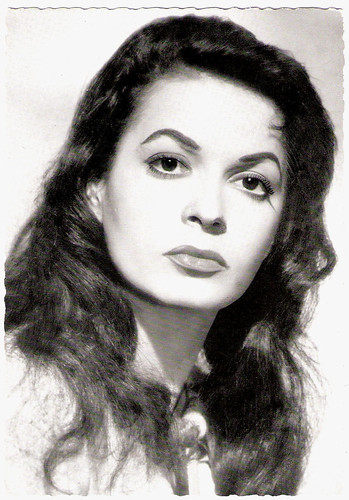
German postcard by Filmbilder-Vertrieb Ernst Freihoff, Essen, no. 162. Retail price: 10 Pfg. Photo: Lilo / Sascha / Herzog-Film.
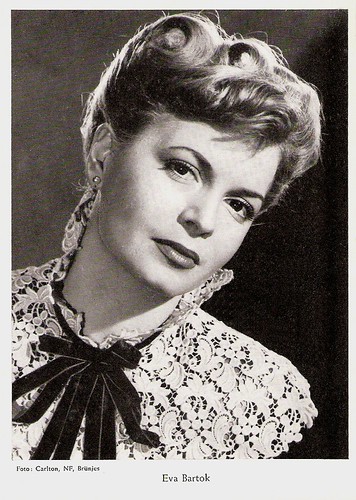
German collectors card. Photo: Carlton / NF / Brünjes.
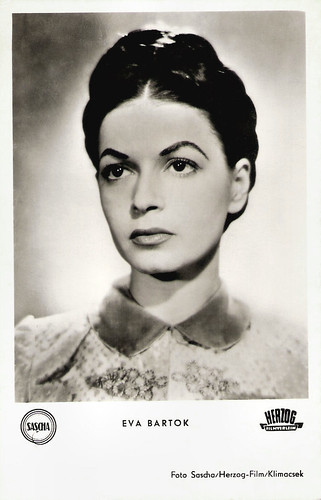
German postcard by Kunst und Bild, Berlin, no. S 553. Photo: Sascha / Herzog-Film / Klimacsek. Publicity still for Dunja/Her Crime Was Love (Josef von Báky, 1955).

British postcard in the Celebrity Series, London, no. 336. Photo: J. Arthur Rank Organisation. Publicity still for Operation Amsterdam (Michael McCarthy, 1959).
Italian trailer for Sei Sei donne per l'assassino/Blood and Black Lace (1964). Source: Neverlando (YouTube).
Sources: Omar Martinez (Eva Bartok: A Tribute), Mark Martin (IMDb), Hal Erickson (AllMovie), Wikipedia and IMDb.
This post was last updated on 4 May 2023.
No comments:
Post a Comment